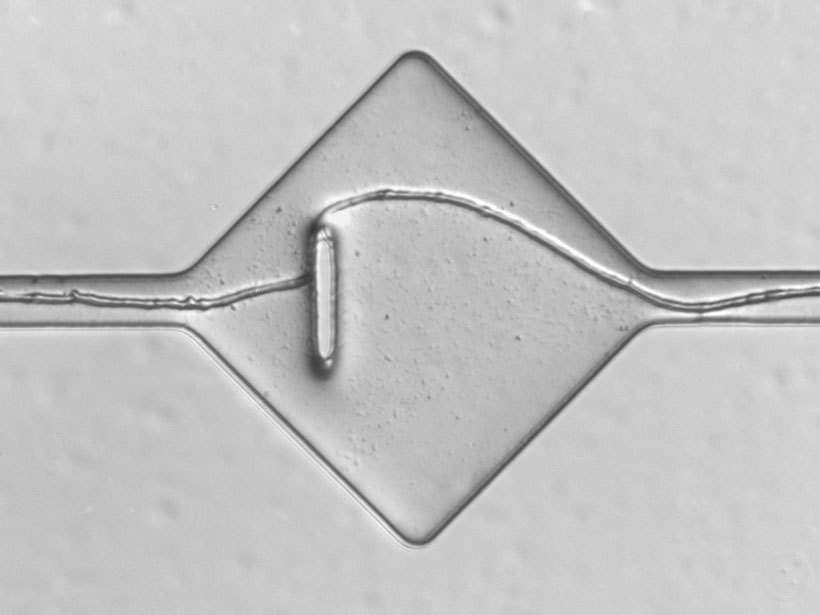What does a fungus do when confronted with a 10-micrometer-wide corridor? It explores, of course. However, if the passage turns out to be a dead end, fungi species will react differently. Some species retreat, some persist, some wreak havoc. Swedish scientists saw it all happen using so-called “soil chips”—small objects that resemble soil at the scale of the organisms that live in it.

Such “micromodels” are literally opening windows into processes that until recently, could be “studied [only] with a black box approach,” said Edith Hammer, a soil ecologist at Lund University in Sweden, where the soil chip was developed. “You do some treatments and then measure the effects in bulk, assuming the soil is homogeneous at centimeter scale. But soil is super heterogeneous at the micrometer scale,” she said. “It is probably the most complex habitat we have on Earth. [There are] microhabitats that can be very different just a few microns apart from each other. That is likely the reason why soil is also the most species dense habitat on Earth.” Only by unraveling the complexities of this habitat can important questions be answered, for instance, about its ability to store carbon.
It’s hard to look inside soil at any scale, let alone at a resolution that allows direct observation of the comings and goings of bacteria and similar-sized life-forms. To get around that, Hammer turned to a technology that routinely creates objects with details measured in micrometers: photolithography, a process used in the fabrication of integrated circuits for computers but which in this case was used to mimic soil composition.
To make a soil chip, a pattern that represents the investigated soil structure is drawn on a “photoresist” layer covering a silicon wafer, which serves as the substrate. After developing the wafer, with only the desired parts of the photoresist remaining, it serves as the mold for a silicon-based organic polymer, polydimethylsiloxane (PDMS). The result is a flat block of PDMS imprinted with pores and voids of dimensions similar to those found in soil. After covering the PDMS with glass, the soil chip is ready for life-forms to enter, spied upon through a microscope.Recently, Hammer’s group published its first results on the behavior of fungi in soil chips. Seven species of fungus had their hyphae, filaments with a growth tip only a few micrometers across, penetrate an “obstacle chip” with a labyrinthine interior. All seven were litter-decomposing species, but they turned out to have very different strategies. Some advanced slowly with multiple hyphae in parallel, while others stormed through the corridors at speeds of over a millimeter a day.
“One species we call the zombie fungus,” Hammer said. “It managed to destroy the chip in a few weeks. But to be fair, the chip did not have an optimal bonding between the glass and the polymer.”
Uncovering the Hidden Lifestyle of Fungi
In actual soil, turning left, right, and back are not the only options for a fungus encountering an obstruction. The two-dimensional character of soil chips makes them less realistic models. But Hammer thinks she can compensate for the lack of the up and down direction in soil chips by increasing the connectivity of their labyrinths.
Lynne Boddy, who studies fungi at Cardiff University in the United Kingdom, has followed Hammer’s work and expects these “lovely little chips” to be important tools in her field, which has been held back by the mostly hidden lifestyle of fungi.
Boddy did note that the Lund University team’s soil chips are “starkly geometric.” “But there’s no reason why you couldn’t make chips that are much more similar to the pore structure of soil, or the vessel structure of wood,” she said.
The same observation came from Philippe Baveye, a soil scientist who, like Boddy, was not involved in Lund University’s soil chip research. He himself has worked with devices similar to soil chips, also made out of PDMS. The chip-like devices Baveye worked with were developed by Leslie Shor of the University of Connecticut. These simulate soil in a different way, by making a computer algorithm prescribe a packing of tiny ellipsoidal particles on the chip, which together simulate the intricate structure of sandy loam soil. According to Baveye, this makes the soil chip more closely mimic the pore space of real soil.
According to Hammer, both approaches—the realistic and the geometric—are useful. In her soil chips, she argued, fungi are presented with clear, uniform choices, where researchers can observe what the hyphae do when presented with a sudden widening of their channel, or with a bend of more than 90° that seems to lead them back to where they came from. “The geometrical spatial models enable us to single out the principal rules that govern microbial responses,” she said.In the future, Hammer does intend to include soil chips that closely model a certain type of soil in her research. “One possibility is using a tomography image of soil, [which] maps the interfaces between solids and air, and using this directly to produce [a pattern] for the chip.”
Her group is also bringing the chips closer to soil in a literal sense. A paper that is still in review will describe what happened when a soil chip was buried in the ground for a time and allowed to become part of the environment.
For future observations of life in soil chips, Hammer plans to go beyond optical microscopy. By replacing the glass lids of the soil chips with suitable materials, her group could study the goings-on inside them with infrared absorption, such as Raman spectroscopy or X-rays.
—Bas den Hond ([email protected]), Science Writer
The Link LonkApril 13, 2021 at 07:27PM
https://ift.tt/3tj9Qj8
Soil Chips Help Scientists Spy on Fungal Navigation - Eos
https://ift.tt/2RGyUAH
Chips

No comments:
Post a Comment